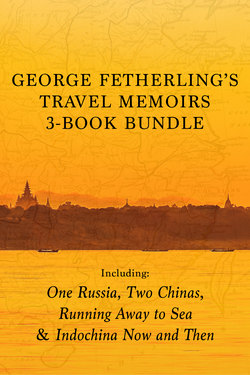Читать книгу George Fetherling's Travel Memoirs 3-Book Bundle - George Fetherling - Страница 35
На сайте Литреса книга снята с продажи.
Photo Insert Part 1
ОглавлениеA quiet street in the Old Quarter of colonial Hanoi in 1922. Note the rickshaw passenger wearing a sola topi.
France’s hold on Indochina began with the acquisition of Saigon, occupied in 1862. These scenes show how thoroughly French the city looked six decades later — by which time Cambodia and Laos had also been assimilated.
In exploring the Mekong River as a possible trade route to China, the French “discovered” the holy city of Angkor in Cambodia, once the seat of Khmer civilization. In the 1870s, Europeans were transfixed by images of its abandoned temples.
When the Mekong proved less than perfect as a commercial highway, the French pursued alternative routes in the neighbouring kingdoms of Annam, whose capital was Hué, and Tonkin, farther north, whose seat was Hanoi.
Postcards of French Indochina, which flourished in the first quarter of the twentieth century, fall into a number of broad categories. Some show native inhabitants going about what seemed their quaint tasks, such as steering a wheelbarrow made of elephant tusks or rolling cigars and cigarettes.
Also popular were portraits of local worthies — not as individuals, but as types, as with these two Annamite gentlemen. Attempts were also made to illustrate the various other social and economic classes, as with this somewhat prosperous Annamite woman (note her European clock) and this Tonkinese man.
Other postcards called attention to French Indochina’s multicultural nature, as when they depicted an ethnic Chinese official in Tonkin, close to the border with China; a Malay in southern Cochinchina; or a group of Japanese dancers in Haiphong.
The urge to make postcards of French Indochina (and other tropical and subtropical colonies) into what the English called “French postcards” evidently could not be resisted, as with this popular image of a Lao dancer or the somewhat less prurient one of une tonkinoise. For pedlars of the exotic, a posed scene in an “opium den” was also de rigueur.
Whether as a royal seat or colonial capital, Phnom Penh never achieved the bustle of Saigon, the dignity of Hué, the charm of Hanoi — or even the peace and quiet of Vientiane. This view of its riverfront makes the point. Nonetheless, the city, like Cambodia as a whole, appealed to ethnologists and pornographers alike.
The French Republic naturally feared republicanism in its colonies, and so it kept the Indochinese monarchies in place. King Sisowath of Cambodia, who ruled from 1904 to 1927, the golden age of French ambition in the region, was expert at pretending to admire the French mission civilisatrice. This portrait was taken in 1906, the year he made his first visit to Paris (he was sixty-six). His entourage for the trip included more than forty dancing girls from his court, such as the one shown here. Her name was Samand.
Then as now, Siem Reap was the gateway to Angkor Wat, one of the world’s most significant religious sites of antiquity.
The Angkor complex is so vast that French scholars restored its main buildings in stages over more than a century, and such work continues even now. But Angkor’s were hardly the only important Khmer temples in Southeast Asia, for the Khmer culture once covered much of modern Thailand and Laos, as well.
